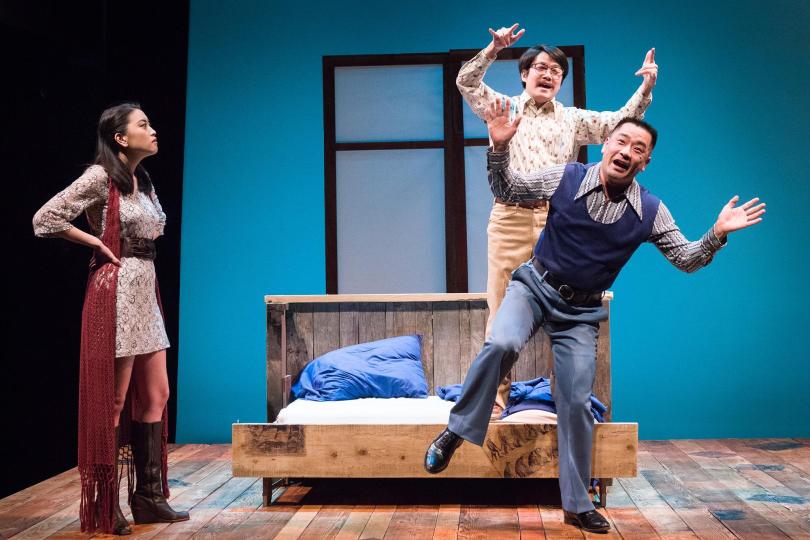Charles Francis Chan Jr.’s Exotic Oriental Murder Mystery

Lloyd Suh doesn’t pull any punches. And in putting on Suh’s play, Mu Performing Arts doesn’t either. Charles Francis Chan Jr.’s Exotic Oriental Murder Mystery explores the pervasive and pernicious effects of racism—casual and otherwise—on the Asian-American experience. Suh’s play is also really funny. Who says dismantling systems of oppression has to be 100% dour 100% of the time? The young and fast-talking Frank Chan—based loosely on writer and activist Frank Chin—has big ideas, big questions, big hopes—but no direction. Faced with being kicked out of school, the end of a relationship, and the possibility of being drafted to fight in the Vietnam War, he spirals. Who is he? What will he do? His crisis brings him to the question of his identity as an Asian-American man (no more “Oriental,” he decides). His father went by Charlie Chan, as in the Chinese detective always played by a white man in yellowface. Indeed, Frank’s own first name is Charles, which he has rejected. Frank recognizes how the dominant white culture of the United States has shaped how he perceives himself and how others perceive him. But it’s time for that to change.
Actor Eric Sharp simultaneously endows the young Frank Chan with gravity and levity. When Frank decides to write a play within the play, Sharp makes him both sympathetic and laughable in the way headstrong young men are. Sharp’s natural charisma makes Frank convincing: why else would independent Kathy Chang—loosely based on artist and activist Kathy Change—spend any time with him? Hope Nordquist is perfectly cast as the budding activist, giving Kathy’s lines an April Ludgate savage bite. This gives her moments of vulnerability all the more strength. The two together make the play spark, underpinning the societal questions the play poses with the personal thread of their burgeoning relationship.
The rest of the cast is uniformly excellent, all adept at the fast-talking, almost vaudeville flair throughout the play. Stephanie Bertumen as Suzy and Eleanor seizes the opportunity to show her range and flex her comedic muscles. Suzy gets a little too into playing an old wealthy white lady, noting how little she’d even have to think about or interact with people of color except when they’re serving her. Song Kim as Frank’s cocky older brother is a joy, and his portrayal of the retiring Alfred is affecting (sidenote on Alfred’s knit vest: perfect choice by costume designer Samantha Fromm Haddow). Luverne Seifert has a lot of heavy lifting to do in his portrayal of the casually racist sergeant and the pidgin-speaking yellowface detective Charlie Chan. Seifert and Sharp share some of the play’s most intense moments, unpacking the stereotypes thrust upon Asian-Americans and the racism they face as well as the often strained relationships between parents of color and their children. Randy Reyes, director of this production and artistic director of Mu Performing Arts, also plays a spectacular Capuchin monkey. In the interest of preserving your delight in this portrayal, I won’t say anything else.
As the audience first enters the Dowling Studio, we hear news clips from the late ‘60s about the Vietnam War, interspersed with peppy commercials for new cars and breath freshener. Whether it’s the restraint of the newscaster or the decision of sound designer Matthew Vichlach to make those commercials seem louder, I don’t know. But it works. At intermission, we hear warbling folk music of the period. The set, designed by Sarah Brandner, comprises two wooden platforms on angles. One platform serves as the main arena for scenes from Frank’s play, while the other is multi-purpose, changing from a recruiting office to a bedroom to a bar with ease. Rolling screens back each platform, and a projection screen—used just twice to great effect by projection designer Kathy Maxwell—sits behind the whole unit. Costumes for the late ‘60s often tend to look, well, costume-y, but Samantha Fromm Haddow’s choices are period- and character-specific. This makes one of Kathy’s stranger hat/headdresses pop all the more. Lighting by Angelina Vyushkova is beautiful, particularly in the several scenes that take place at a make-up table in front of the set.
The audience sees bits and pieces of the play that Frank decides to write, though as the performance goes on, Frank’s play and Suh’s begin to blur and bleed together (it put me a little in mind of the movie Synecdoche, New York). This reminds the audience that so many forms of entertainment end up shaping our everyday experiences and informing our prejudices. Early in the play, Frank tells the sergeant, “The purpose of stereotypes is to maintain order.” Frank riffs on these stereotypes in his own play, hoping to expose them as the shallow and hateful characterizations that they are. Sadder than stereotypes, Frank later says he never sees anyone that looks like him on TV. The question of representation still dogs us today.
Staged as a part of the Level Nine Initiative at the Guthrie Theater, Charles Francis Chan speaks with urgency about the depictions, or lack thereof, of Asian Americans—and, indeed, all Americans of color. The audience comes to terms with the near total absence of Asian Americans in all forms of entertainment. Who is the greatest Asian-American character in all of our media? How many Asian-American actors are given the opportunity to play more than the best friend or the assistant or [insert secondary or tertiary role here]? Aziz Ansari skewers this in the first season of his show Master of None when his character arrives at an audition room filled with other Indian-American men. They don’t want him; they want his type. Frank Chan and Lloyd Suh are only interested in stereotypes when they can lean into them, expose their ridiculousness, and smash them. They urge us to continually interrogate the stereotypes handed down to us by our families, by friends, by the media, by history, by society.
About the play, Suh writes, “I hope the play is in service of the next generation of Asian America, in hopes that they don’t have to ask themselves the same questions we’re asking now, the same questions those pioneers in the 1960s were asking the world.” For all of our sakes, I hope the same thing. I hope you see Charles Francis Chan and you laugh and you are moved and when you get to the lobby you ask yourself, What can I do to lift up authentic Asian-American voices in the arts and popular media? And then I hope we all go do that. As Frank says, “The world changes through action.”




